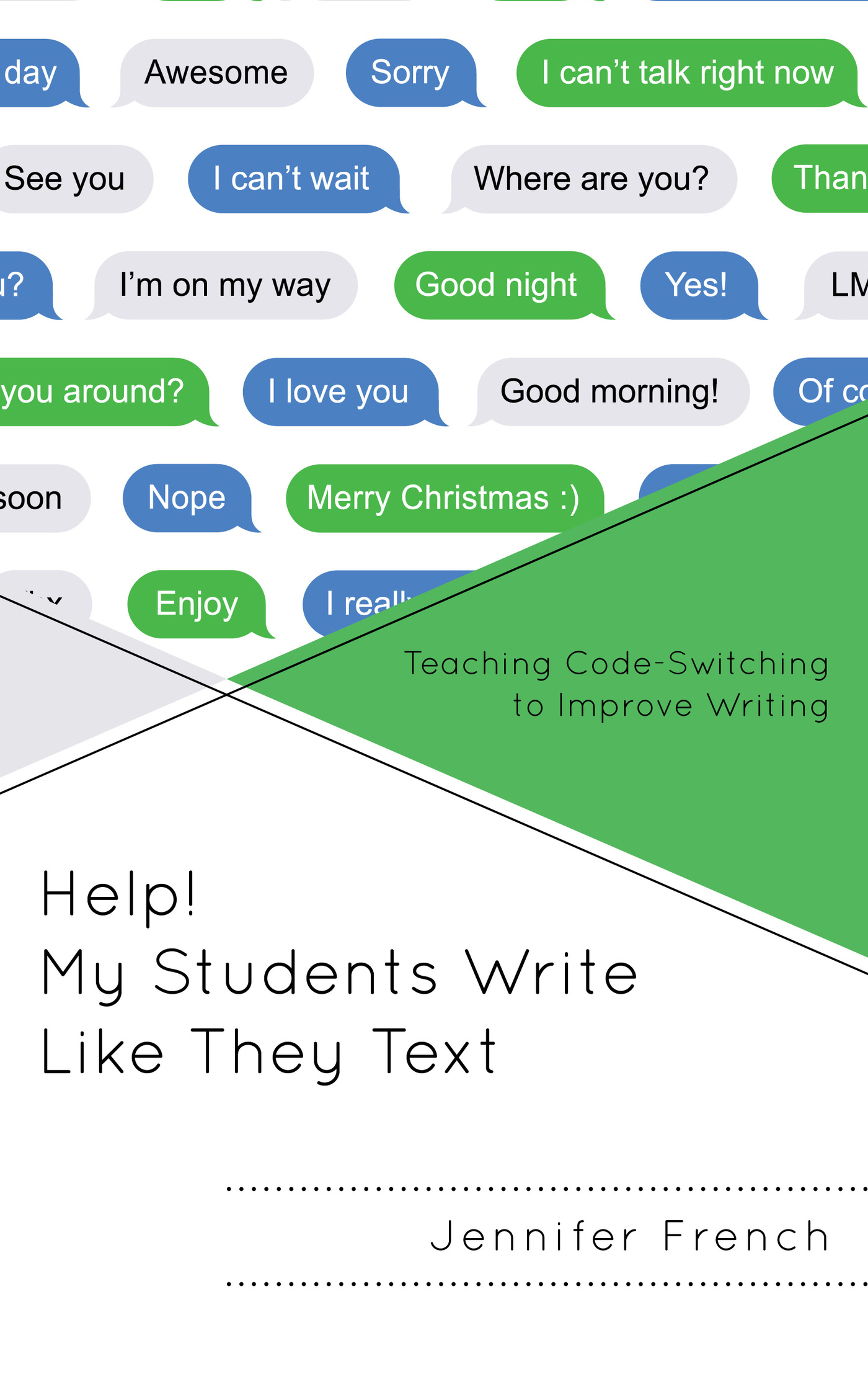Help! My Students Write
Like They Text
Help! My Students Write
Like They Text
Teaching Code-Switching to
Improve Writing
Jennifer French
ROWMAN & LITTLEFIELD
Lanham Boulder New York London
Published by Rowman & Littlefield
An imprint of The Rowman & Littlefield Publishing Group, Inc.
4501 Forbes Boulevard, Suite 200, Lanham, Maryland 20706
www.rowman.com
Unit A, Whitacre Mews, 26-34 Stannary Street, London SE11 4AB
Copyright 2018 by Jennifer French
All rights reserved. No part of this book may be reproduced in any form or by any electronic or mechanical means, including information storage and retrieval systems, without written permission from the publisher, except by a reviewer who may quote passages in a review.
British Library Cataloguing in Publication Information Available
Library of Congress Cataloging-in-Publication Data
Names: French, Jennifer, 1979- author.
Title: Help! my students write like they text : teaching code-switching to improve writing / Jennifer French.
Description: Lanham, Maryland : Rowman & Littlefield, [2018] | Includes bibliographical references.
Identifiers: LCCN 2018012524 (print) | LCCN 2018028088 (ebook) | ISBN 9781475839463 (electronic) | ISBN 9781475839449 (cloth : alk. paper) | ISBN 9781475839456 (pbk. : alk. paper)
Subjects: LCSH: Language arts (Secondary) | English languageComposition and exercisesStudy and teaching (Secondary) | Text messages (Cell phone systems) | Code switching (Linguistics)
Classification: LCC LB1631 (ebook) | LCC LB1631 .F696 2018 (print) | DDC 428.0071/2dc23
LC record available at https://lccn.loc.gov/2018012524
 TM The paper used in this publication meets the minimum requirements of American National Standard for Information Sciences Permanence of Paper for Printed Library Materials, ANSI/NISO Z39.48-1992.
TM The paper used in this publication meets the minimum requirements of American National Standard for Information Sciences Permanence of Paper for Printed Library Materials, ANSI/NISO Z39.48-1992.
Printed in the United States of America
Trent, because of you I can make my dreams possible. Samuel, Nathan, Hannah, and Jackson: Youre the reason education matters <3
Foreword
Jennifer French, a forward-thinking and inspired educator, is never afraid of a challengeand researching the effect of texting on student writing is definitely not an easy task.
I met Dr. French when I was brought in as a consultant to Anderson Public Schools, Indiana. At that time, she had already begun questioning how the act of texting affected student writing. Like most of our colleagues, she and I assumed that the effect was mostly negative. How could short bursts of two-thumbed keyboarding, resulting in messages consisting largely of abbreviations and acronyms, help student writers learn to craft sentences, let alone paragraphs? But as Dr. Frenchs research progressed, she realized that she had to rethink these assumptions. It turns out that writing, specifically in English, is a malleable skill that can be positively influenced by many unexpected variables, including texting.
The fact is many of us now walk around with powerful computers in our pockets. The speed at which we can gather, digest, and share information is truly mind-boggling. As French points out in her opening chapter, contemporary language development simply reflects this momentum and efficiency. Todays students are as comfortable with search engines as my generation was with the now-archaic card catalogue. The beauty of living language is that it reflects the changes in a society and culture. Textspeak, with all of its quirky abbreviations and acronyms, has become commonplace. Even though words and phrases like SMS and LOL are already in the dictionary, teachers cant help but fear theyre witnessing the death of Standard English.
But fear not, good teachers! Dr. French is an educator to the core, and as such she is happy to share her newfound discoveries and keen insights about texting and its effects on student writing. In her opening chapter, she explains the dynamic attributes of language and how they affect our students. As French points out, it is essential that literacy instructors embrace this notion. To be truly responsive educators, we must accept that the demands of language now include texting.
The author furthers her exploration in chapter 2, where she focuses on different types of learners, including English language learners. She continues in chapters 3 and 4 by considering the essential skill of code switching. Thats the skill that allows us to transition back and forth between formal and casual language and recognize the appropriate contexts and settings for each. She concludes in chapter 5 by sharing concrete classroom activities and comprehension strategies that will help students recognize and navigate various contexts and settings.
Indeed, the most valuable aspect of Dr. Frenchs book is her ability to translate her research into practice. Much of this book is dedicated to providing teachers with real solutions, instructional ideas, and lessons that embrace texting. Our students use of texting can and should be used to liberate and empower writing skill development. Dr. French has shown us how to do so in this excellent resource for educators.
Katherine S. McKnight, PhD
Founder, EngagingLearners.com
Acknowledgments
I would like to thank all of my colleagues and friends for their willingness to try something new.
Id also like to acknowledge Dr. Katie McKnight, a personal mentor and a beloved friend. She has made me a better teacher and a stronger woman.
Introduction
IMHO, LOL, OIC, OMG. If youve recently graded middle school or high school writing, chances are youve read terms like these; or my favorite, wtf idk, which also happened to be an answer on a students quiz. As a middle school English teacher, I became more and more perplexed to see students using texting talk on their homework and classroom writing assignmentsnot to mention answers on the writing portion of the state standardized test. My students were not differentiating appropriate writing contexts. The answers written on the unit test were written the same way that they invited their friends to hang @ *$ (Starbucks).
It was 2005, and almost every one of my 140 eighth-graders had their own cell phone; much of the time it was a model newer than mine. In my school district, the majority of discipline referrals between 2006 and 2008 were written because of student cell phone misuse. The clever students were able to text answers to a student in another class by blindly texting from their hoodie pockets. Students who could escape teacher view would take a photo of someone elses completed work to copy later. Sneakiness had a new platform. Confiscating cell phones meant calls l8r (later) from angry parents. My colleagues and I were fighting a losing battle, and our students were ROFL (rolling on floor, laughing).
The greatest challenge from cell phones was the birth of textspeak. Textspeak relies on shortcuts by utilizing acronyms, shortened misspellings, and the avoidance of grammar. It was everywhere. It was the first decade of the twenty-first century, and the textspeak plague was spreading. Teachers were complaining to administrators, and parents were complaining to teachers. Textspeak was quickly corroding English language. Thus, I began my quest to save Standard English from the clutches of middle schoolers. As my journey began, I was certain of what I would find: high doses of texting directly correlating to lower writing grades and test scores.
Next page
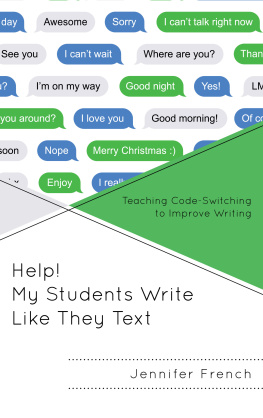



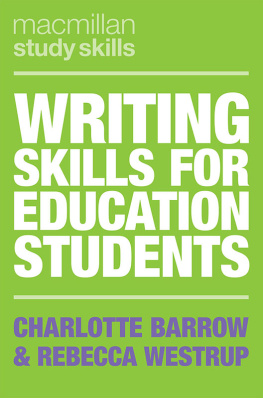

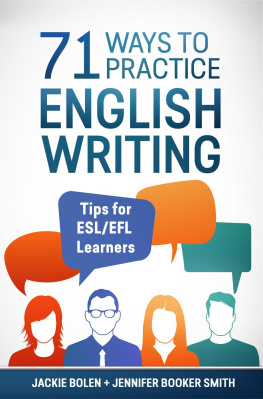

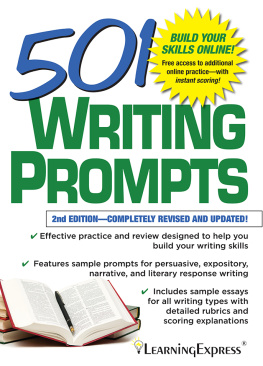
 TM The paper used in this publication meets the minimum requirements of American National Standard for Information Sciences Permanence of Paper for Printed Library Materials, ANSI/NISO Z39.48-1992.
TM The paper used in this publication meets the minimum requirements of American National Standard for Information Sciences Permanence of Paper for Printed Library Materials, ANSI/NISO Z39.48-1992.